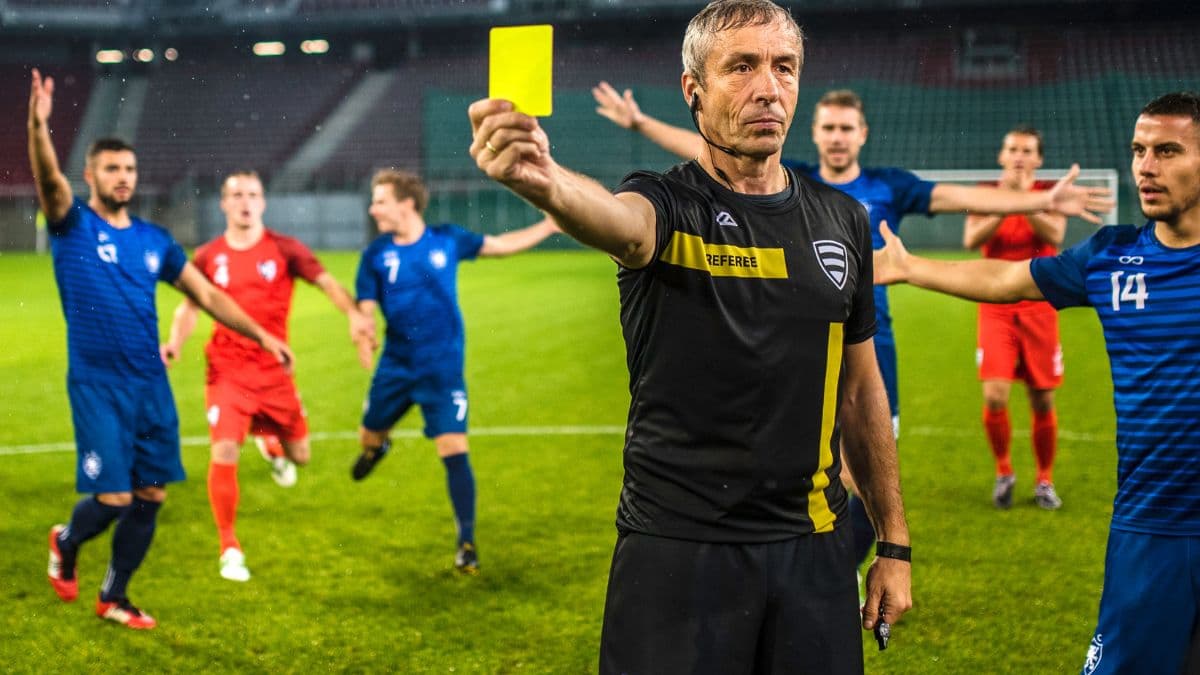10 Rules and Regulation of Playing Football
By Pinkey Sharma |
Date 22-08-2024

Table of Contents
- Football Rules and Regulations
- Rule 1: Field of Play
- Rule 2: The Ball
- Rule 3: Number of Players
- Rule 4: The Equipment
- Rule 5: Game Duration
- Rule 6: The Start and Restart of Play
- Rule 7: Throw-Ins, Goal Kicks, and Corner Kicks
- Rule 8: Offside Rule
- Rule 9: Fouls and Misconduct
- Rule 10: Free Kicks and Penalties
- Why Do the Rules of Football Be Obeyed?
- Conclusion
- FAQs
Admissions Open for
Football is a "beautiful game" and loved by hundreds of millions in almost every corner of the world. Be it playing with your mates in the park or watching your favorite team on TV, knowledge of the rules of football is something of priority. These football rules and regulations will ensure that the beautiful game of football remains an enjoyable and safe game for everyone throughout the competition. This article brings forth the basic 10 rules of football that every single person, be it a player, parent, or just a fan, should know. Fear not, for we will take it in as simple steps as possible so you may understand!
Football Rules and Regulations
But before going into that, let us briefly address what football rules are and why the rules are very important to the game. They may, in simple words, be regarded as a set of instructions for playing the game and guiding what actions the players, referees, and coaches should take. Actually, these rules are a description of the "instructions" of the game, which makes sure that everybody is aware how to act and what to do in a particular situation while playing fair games.
Why Do We Need Rules in Football? Just imagine playing a game in which everybody does everything that goes through their mind. That, besides being none of the other players' understanding of what's going on, would certainly not be fun. The rules of football will lead everybody on how to play, what is allowed, and what is not. They also put structure around the game, ensuring players are safe.
These are the basic 10 rules of football, which are very essential in maintaining the organization of the game and ways in which it's squared. We will discuss each one of them in detail.
Rule 1: Field of Play
The pitch or field area of football is a football field. It is simply a large, rectangular area where the game is to take place. It follows that, although there are rules for a football pitch, in following the rules of football it may be necessary for a better understanding of how a field is structured.
Size and Layout: A standard football pitch is approximately 100-130 yards in length and 50-100 yards in breadth. There are various markings on it—the halfway line, the penalty area, the goal area, and a center circle. Of course, one could see goals from either end of the playing field. The entire competition takes place between two of them with the purpose of winning the possession of the ball and seeing that the ball is driven through the opponent's goal.
Penalty Area: A special area in front of each goal. If an opponent fouls a player located within this area, his or her team has a chance at a penalty kick.
Goal Area: It is a small area inside the penalty box that is usually occupied by the goalkeeper.
Center Circle: This is a circle where the game is initiated by the kick off.
One can familiarize themselves with the diagram of a football field to help them know where they should position themselves and what some places are meant for during the game .
Rule 2: The Ball
The next rule would be concerning what many would consider the most vital of equipment related to the football game: the ball! It suggests the understanding of the rules regarding the ball in football, which are critical tenets governing how this play is to be properly conducted.
Size and Type: The ball shall be essentially made of leather or any other similar material; round. It is to be of size 5 according to the standard size and for senior and professional matches. Size 3 and 4 balls may be used for juniors and players younger in age respectively.
Afterwards, the football should be well-preserved. It would mean that it has the correct pressure when inflated and is free from damage. A well-preserved ball will ensure that the game flows in a manner that is prescribed by the rules of football.
Rule 3: Number of Players
Now, besides that, it is the number of players who have to take part in the field. It happens to be one of those really simple rules of football that any player should know.
A normal game of football is run with an average of 11 players, one keeper. Only the keeper is legally allowed to use hands; the rest of the 10 have different roles classified into three categories: defenders, midfielders, and attackers.
Substitutes: Teams are also allowed to make substitutes. These are additional players who may substitute a tired or injured player during the game. Normally, a team can replace up to three players in a match though; this varies from one competition to the other.
Rule 4: The Equipment
The number of players and their position makes the children understand how a football team is constituted and why they are key players in that team.
To practice safely this very demanding contact sport and to play properly, participants must always be equipped, and this is one of the rules of football, which protects safety and comfort while playing.
Clothing to wear
The Game Uniform: This consists of a shirt, shorts, and socks for each player. The uniform helps in easy identification of the player's team.
Shin guards: They are worn under instep socks to protect shins from kicks and collisions.
Football boots: Footballers wear special shoes that are popularly known as football boots. Studded at the bottom side of the football boots to stick with the grass.
Use of Safety Wear: Proper dress code is going to be imperative to adhere to the rules of football, but also to prevent the players from the brink of injuries. For instance, shin guards can save the player from some tedious bruises, while the football boots give the needed grip for running and quick turns on the field.
Rule 5: Game Duration
Probably, the most undemanding things that a person can describe about football rules and regulations have to do with the duration of the game, which is something really one should get to know in a very inaugural place.
Game Duration: A standard football game is 90 minutes long. It is divided into two halves, each half lasting 45 minutes. In between the two halves is a 15-minute half-time interval. This will allow them to rest a bit, drink some water, and talk about the game with the coach.
Extra Time: A bit of extra time is added at the end of each half; it is called "stoppage time" or "injury time." From a gameplay perspective, though, it really functions as a system of tacking on time to replace playing time lost during the course of the game due to injuries, substitutions, and other mishaps.
This aids the players in working out the level of their energy and, at the same time, knows the remaining time left in the game.
Rule 6: The Start and Restart of Play
Rule 6 explains how to kick off and how to kick off again. Knowing all these football rules and regulations that need to be applied in games helps kids follow through with the flow of a game.
Kickoff: The game started with one of the two teams putting the ball into play from the center of the field. Kickoff is awarded through winning the coin toss, either by kickoff or the attacking direction of a goal. A kick-off also marks the beginning of the second half and the restart after a goal has been scored.
Rule 7: Throw-Ins, Goal Kicks, and Corner Kicks
Throw-In: When the ball goes out through the touchlines, then the team that didn't last touch it gets to have a throw-in. The ball has to be thrown in with both hands from behind their head.
Goal Kick: In case the colorful team kicks the ball outwards, past the white team's last line, and does not enter between the goal posts, then the white team gets to have a goal kick.
Corner Kick: When, during defending a team kicks the ball beyond the edge of its goal line, then a corner kick is awarded to the attacking team. It is taken from the extremity of the field nearest to the goal.With these laws, the game becomes very fluid, yet very structured at the same time.Everybody likes scoring goals; probably that's where the real action is in football! Let's discuss the football rules that underline how to score a goal.
How to Score: It simply requires setting a goal when the whole ball has crossed the goal line under the crossbar amidst the goalposts. Basically, all that matters is that it is within the rules; it doesn't matter who kicked the ball or how it went in. It won't count for a goal if a player is in an offside position during the delivery of the ball to him.
Handballs: In case of contact by any other player other than a goalkeeper by hand, no amount of goal scored downstream counts.
Scoring goals is actually the prime objective of the football game, and these rules ensure goals are scored in a fair manner.

Rule 8: Offside Rule
Offside can probably be one of the trickiest football rules. Let us break it down completely so you will understand what we mean by that.
What is Offside?
A player shall be declared offside if he is less distant to his opponent's goal line than the ball and the second last defending player when the ball is being played to him. However, a player will not be considered offside if he is on his half or positioned with the last second defender.
Why is it Important?
The offside rule avoids the situation of "goal-hanging" or "goal-side staying" of players for free scoring, always near the opponent's goal. This keeps the game competitive and the fairness of it.
Example: Imagine a player next to a goal, waiting for the ball, and all the other players were very far away. That wouldn't be fair if he wanted to score when given the ball, right? So the offside rule helps block that from happening.
If the children are equipped with knowledge of the offside rule, they will be in a perfect place to follow the game closely and even form for themselves why some scored goals are not counted.
Rule 9: Fouls and Misconduct
From time to time, while in the game, football players will commit mistakes either purposely or not purposely committed. These mistaken acts are called a foul or misconduct.
What is a Foul?
A foul is when a player breaks the rules by causing another player to trip, that is to say it is a push, or hand-balling, etc. Of course, this does not include the goalkeeper. When a foul occurs, a free kick is usually awarded to the other team.
Yellow and Red Cards
The yellow caution card is a warning to the player for commissioning any foul or unsporting behavior. If in a one match, a player commits two yellow-card offenses, he receives a subsequent red card.
Having these rules regarding fouls and misconduct makes the game safer and fairer because of the enforcement of respect in playing by the players.

Rule 10: Free Kicks and Penalties
Now, finally, what most people refer to as free kicks and penalties —the special part of football rules and regulations.
Free Kicks
When the offense has been made, then it results in the free kick by the opposite team. These are into two categories:
Direct Free Kick: Any player can do a direct kick to the ball for a goal.
Indirect Free Kick: It doesn't score directly; in that case, it had to touch another player.
Penalty
A penalty is an awarded foul in a penalty area. Only one player is lucky enough to shoot it from the penalty spot with only the goalkeeper in between him and the net. Penalties are huge; most of the time they wind up in goals!
Knowing what free kicks and penalties entail helps children to understand why certain moments in the match are so important and pressure-filled
Why Do the Rules of Football Be Obeyed?
The rules in the game of football shall be made to make the game interesting, fair, and safe for all parties involved. If one adheres to the rule, it then becomes respect for the game and an opponent; in any case, this player does not. The rule will make the game confusing and is not fair.
Now, just think of the game play in a play of this game where everyone didn't follow the rules. It would lead to Chaos and no one could understand what was taking place. That is why it would be oh so very important to have football rules learned and understood for the benefit of all, so that the game would be enjoyed by everyone.
Conclusion
We have discussed the basic 10 rules of football at the core of every player or fan. The size of the playing field and the offside rule are all part of the reasons which make football today such an exciting yet very fair game.This is so that, whether you are on the field with friends or whether you are watching at home on your television set, you will have much to enjoy because of the rules of these games of football. The next time you penetrate the field, keep these in mind and get down to enjoying the beautiful game.
FAQs
1. What if a football player breaks one of the rules?
A football player's infraction against a football rule might let the opposing team win a free kick. It may also lead to the player receiving a yellow or red card and being shown a penalizing or warning card.
2. How Many Football Players are Allowed in the Ground at a Time?
At a time, there may be 11 over ground players at a time and one of them must be a goalkeeper; these are the basic rules of football.
3. Explain the Off-Side Rule in Football?
The offside rule is in place so no player can be in front of the opponent's goal more than what is constituted by the ball and the second-last defender when the player receives the ball. It makes the game just.
Liked what you read? Feel free to share this article with your friends and spread the knowledge!
CBSE Schools In Popular Cities
- CBSE Schools in Bangalore
- CBSE Schools in Mumbai
- CBSE Schools in Pune
- CBSE Schools in Hyderabad
- CBSE Schools in Chennai
- CBSE Schools in Gurgaon
- CBSE Schools in Kolkata
- CBSE Schools in Indore
- CBSE Schools in Sonipat
- CBSE Schools in Delhi
- CBSE Schools in Rohtak
- CBSE Schools in Bhopal
- CBSE Schools in Aurangabad
- CBSE Schools in Jabalpur
- CBSE Schools in Jaipur
- CBSE Schools in Jodhpur
- CBSE Schools in Nagpur
- CBSE Schools in Ahmednagar
- CBSE School In Tumkur

Call Us to know more about Orchids
Swipe Up



.jpg&w=1920&q=80)












